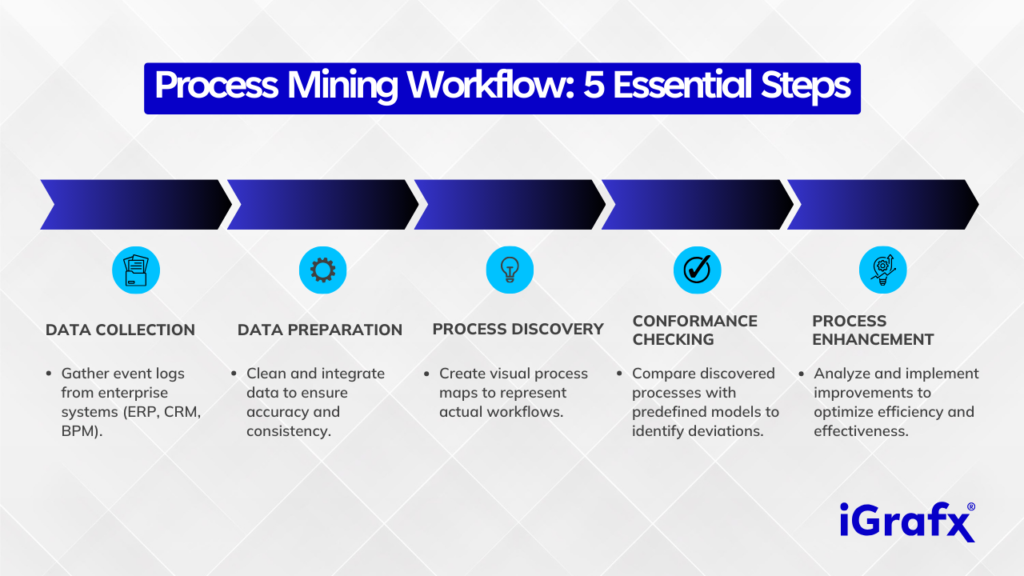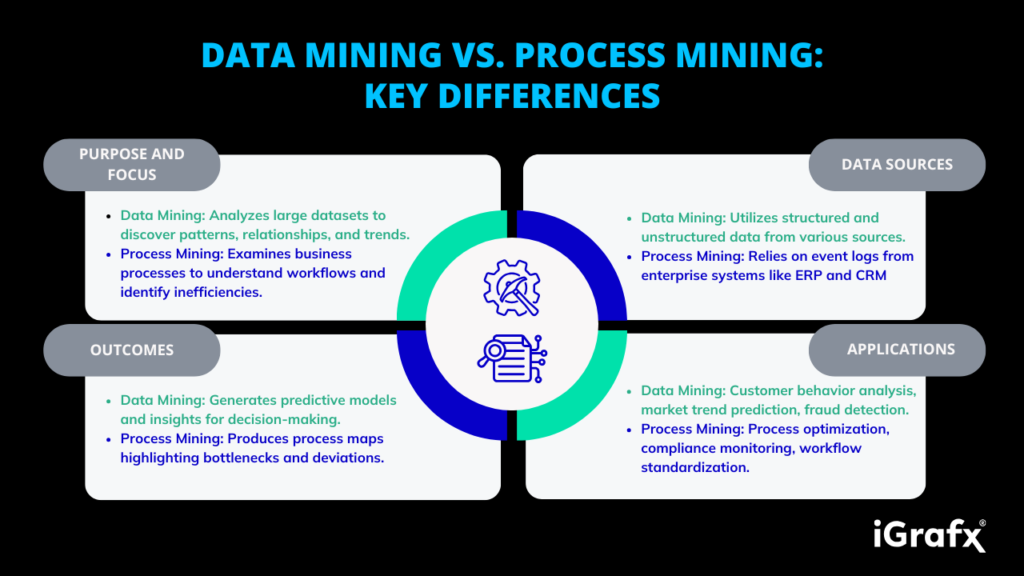Companies today are drowning in data and tangled in processes. They collect endless streams of information: customer clicks, sales figures, employee metrics, and system logs. Meanwhile, their business processes grow more complex – orders flow through dozens of steps, customer service requests bounce between departments, and supply chains stretch across continents.
Making sense of all this complexity isn’t just difficult – it’s becoming impossible to do it manually. That’s why companies turn to data mining and process mining. These two approaches tackle different aspects of the same fundamental problem: how to turn raw information into actionable insights.
Both tools extract valuable insights from data, but they do so in fundamentally different ways. Understanding the differences between these two methods can help businesses choose the right approach for their specific needs. In this blog, we will explore:
- The definitions of process mining and data mining
- How they work
- Key differences and similarities
- Use cases and actionable takeaways for businesses aiming to achieve operational excellence
What is Data Mining?
Data mining is a technique used to analyze large datasets in order to discover patterns, relationships, and trends. This field leverages algorithms and machine learning techniques (e.g. Association Rule Learning, Regression analysis) to process data and uncover valuable insights that would otherwise be impossible for humans to spot manually.
The key goal of data mining is to extract meaningful information that can guide strategic decisions.
How Data Mining Works
Traditional data mining methods rely on various data mining tools and techniques, from statistics, machine learning, and artificial intelligence, to analyze historical data and predict future trends. The process typically involves:
- Data Collection and Preparation: Gather data from various sources and clean it to ensure accuracy.
- Data Integration: Combine data from different sources to create a unified dataset.
- Data Analysis: Use data mining techniques and algorithms to find patterns and relationships within the data.
- Interpretation and Evaluation: Translate the findings into actionable insights.
Example of Data Mining
The classic example is the (possibly apocryphal) story of the supermarket that discovered through data mining that people who buy diapers often buy beer at the same time. This makes sense in retrospect – new parents are stuck at home and want beer – but no one would have guessed it without analyzing the data.
Data mining is particularly good at finding these non-obvious connections. But it goes beyond just finding correlations.
Consider a bank using data mining to detect fraud. The data mining software might notice that fraudulent transactions often happen in a particular sequence: first a small test purchase, then a series of larger ones. No human would spot this pattern across millions of transactions, but data mining can find it easily.
What is Process Mining?
Process mining exists because organizations often don’t really know how their processes work. They have official flowcharts showing how things are supposed to work, but the reality is often messier. This messiness creates inefficiency.
A study by IDC found that operational inefficiency costs companies 20-30% of their revenue each year. That’s a lot of money being wasted because processes aren’t working as well as they could.
Process mining focuses on analyzing the workflows and activities within an organization. It uses event logs generated by enterprise systems such as ERPs (Enterprise Resource Planning), BPMs (Business Process Management), and CRMs (Customer Relationship Management) to map out, understand, and analyze how processes are being executed in real life.
Process mining aims not only to understand the existing data but also to visualize and optimize business processes. This technique creates a detailed “as-is” map of the operational processes, identifying inefficiencies, bottlenecks, and deviations from standard operating procedures.
How Process Mining Works
Process mining works by reading the digital footprints left in your corporate systems. Every time someone does something in your business software – creates an order, approves an invoice, updates a customer record – it creates a log entry.
Process mining tools string these entries together to show you exactly how work flows through your organization.
The approach is systematic:
- Data Extraction: Collecting event logs from enterprise systems like ERP, CRM, and BPM. The data must be ‘clean,’ and sometimes must be combined from various sources, before it can be used in the next step.
- Process Discovery and Data Visualization: Creating visual representations (process maps) of actual processes based on event log data.
- Conformance Checking: Comparing the discovered process with predefined models to identify deviations.
- Process Enhancement: Analyzing the process to identify bottlenecks and inefficiencies, discover trends and patterns that might not otherwise be clear, and then suggesting improvements.
Example of Process Mining
In supply chain management, process mining can be used to map out the flow of materials and goods from suppliers to customers. By visualizing the supply chain process, businesses can identify delays or inefficiencies, such as slow-moving inventory or shipping delays, and make improvements to enhance customer satisfaction and reduce costs.
A manufacturing company might use process mining to understand why some orders take longer to fulfill than others. The process mining software might reveal that orders above a certain size always get delayed because they require an extra approval step that wasn’t in the original process design.
Key Differences Between Process Mining and Data Mining
While both data and process mining techniques aim to provide insights from data, their focus and methodologies are different. Let’s break down the key differences:
Purpose and Focus
Process Mining:
- Focuses on how processes flow through an organization
- Creates visual representations of actual process execution
- Identifies operational inefficiencies and bottlenecks
Data Mining:
- Analyzes broader patterns and relationships in data
- Discovers hidden insights and trends
- Predicts future outcomes based on historical static data
- Focuses on what patterns exist within datasets
Data Sources and Analysis
Process Mining:
- Primarily uses event logs from enterprise systems
- Analyzes sequential activities and timestamps
- Tracks process variations and deviations
- Creates process maps from data, can easily be updated with additional executions of the process, and can use AI predictive analysis to identify problems before they occur
Data Mining:
- Uses structured and unstructured big data from various sources
- Analyzes static historical data
- Applies statistical and mathematical models
- Creates predictive models and pattern analyses
Applications and Outcomes
Process Mining:
- Process optimization and improvement
- Compliance monitoring and auditing
- Enhancement of Operational efficiency
- Workflow standardization
- Automation opportunity identification
Data Mining:
- Customer behavior analysis
- Market trend prediction
- Risk assessment
- Fraud detection
- Product recommendation systems
Process Mining vs Data Mining Comparison Table
Here is a comparison table that outlines the key differences between Data Mining and Process Mining for easy understanding:
| Feature | Data Mining | Process Mining |
| Level of Analysis | Finding patterns, trends, and relationships in large datasets. | Analyzing and optimizing business processes using event logs. |
| Data Source | Diverse sources including structured data from databases, data warehouses, and sometimes unstructured data like text, images, or web activity. | Event logs from company systems such as ERP, CRM, or BPM platforms. |
| Methodology | Uses statistical and machine learning techniques to automate the discovery of patterns and relationships. | Uses process discovery, conformance checking, process enhancement, and predictive analysis. |
| Nature of Analysis | Conducts static analysis of concrete data as a whole to find general trends. | Involves analysis focusing on the flow of activities across processes. |
| Temporal Focus | Emphasizes historical data to predict future trends. | Focuses on ‘real-time’ and historical process execution. |
| Exception Handling | Often discards outliers. | Analyzes deviations and exceptions for process improvement. |
| Output | Predictive models, patterns, trends. | Process models/flowcharts, bottleneck identification, predictive analysis of future behavior. |
| Business Use | Identify hidden patterns and relationships. | Visualize actual processes and identify inefficiencies. |
| Scope of Application | Broad applications such as marketing, finance, and fraud detection. | Can be used in almost any business as it focuses on process optimization within business operations. |
Similarities Between Data Mining and Process Mining
Despite their differences, there are several similarities between data mining and process mining.
- Data-Driven: Both rely on data analysis to uncover insights.
- Use of Algorithms: Employ statistical and computational techniques.
- Business Intelligence Integration: Assist in making informed decisions.
- Handle Large Datasets: Capable of processing vast amounts of information.
When to Use Data Mining and/or Process Mining
The decision to use either data mining or process mining depends on the specific needs of a business. Here are a few considerations for each:
Use Data Mining:
- To identify trends and uncover hidden patterns in large datasets.
- To develop predictive models for decision-making or knowledge discovery.
- To analyze market trends and customer behavior.
- To detect fraud or anomalies in financial data.
Use Process Mining:
- To visualize and optimize actual business processes.
- To identify operational inefficiencies.
- To ensure compliance with predefined procedures or industry regulations. Process mining can show where people are deviating from required procedures, whether those deviations are causing problems, and whether the official procedures might need updating.
- To implement automation and transformation initiatives.
Integrating Data Mining and Process Mining
While these two techniques are distinct, they can complement each other when integrated effectively. Here is how they can work together:
- Enhanced Insights: Data mining can uncover customer behavior patterns, while process mining can show how these behaviors influence workflows.
- Strategic Decision-Making: Combining the broader trends identified by data mining with the operational insights from process mining enables better strategic planning.
- Continuous Improvement: Use data mining to identify long-term trends and process mining to address immediate inefficiencies.
For example, a retailer might use data mining to predict customer demand for certain products and process mining to streamline inventory management processes to meet that demand efficiently.
What This Means for Business
For most businesses, the message is clear: you probably can utilize both approaches. Data mining helps you understand your market and customers. Process mining helps you understand and improve your operations.
The companies that get the most value from these tools are the ones that understand this distinction and use each tool appropriately. They use data mining to spot opportunities and process mining to execute efficiently.
Ultimately, it is not about choosing between data mining and process mining. It is about understanding that there are different tools for different jobs. Just as you would not try to hammer in a screw, you do not want to try to use data mining to understand your processes or process mining to predict customer behavior.
The smartest companies will use both, each for what it does best. And they’ll win because they’ll both understand their market and execute efficiently. In business, that’s usually an unbeatable combination.
If you’re ready to take the next step in improving your business processes, iGrafx’s process intelligence platform can help you transform your operations and align them with your business strategies. Book a demo today to learn how process mining can unlock new opportunities for your business.



